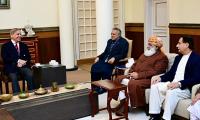Since independence, numerous educational policies have been implemented to improve the education system of the country and achieve universal education.
However, despite these reforms, the state fails to provide free and quality education to all children. Official data released by the Pakistan Bureau of Statistics (PBS) shows that the population that ever-attended school decreased from 62 percent in 2014-15 to 60 percent in 2019-20. Regional analysis also shows a decline in attendance rates in urban and rural areas in 2019-20. The ever-attended school ratio declined from 77 percent in 2014-15 to 73 percent in 2019-20 in urban areas and from 53 percent to 52 percent in rural areas during the same time. Likewise, the completion/survival rate (grade 1 to 5) is very low (only 67 percent). The literacy rate (10 years and older) has stagnated at 60 percent over the past decade.
Another notable feature of educational outcomes is the existence of inequalities between the provinces. Provincial analysis shows that Punjab has the highest literacy rate (64 percent), followed by Sindh (58 percent), Khyber Pakhtunkhwa (53 percent) and Balochistan has the lowest literacy (46 percent). Similar disparities exist within the province; for example, in Punjab, Rawalpindi has the highest literacy rate (82 percent) while Rajanpur has the lowest literacy rate (42 percent).
As a next step, the prime minister recently launched the ‘Ehsaas Taleemi Wazaif’ programme to increase enrollment rates, especially among girls. The programme aims to enroll 1.75 million additional students during the current fiscal year. Under this programme, scholarships will be awarded to deserving students, aged 4 to 22, from low-income groups. The beneficiary boys will get a stipend of Rs1,500 and girls Rs2,000 on a quarterly basis for primary education. For secondary school education, boys will receive Rs2,500 and girls Rs3,000; and at higher secondary level, boys will get Rs3,500 and girls Rs4,000 quarterly. The government has been running this programme, Waseela-e-Taleem (WeT), since 2012 and has claimed that 4.45 million students have been ever-enrolled across the country.
Despite these claims, the official data by the PBS presents a totally different picture. Around 22 million children between the ages of 5 and 16 are out of school, the second highest number of out of school children (OOSC) after Nigeria. Children who do not go to school are higher in the rural areas (37 percent) compared to urban areas (22 percent). Punjab has 24 percent OOSC, followed by KP (32 percent), Sindh (44 percent) and Balochistan (47 percent).
The government-provided stipend is not enough to prevent dropouts. It is evident that a child can earn between Rs5,000 and Rs10,000 per month in local markets. On the other hand, the financial assistance provided by the government is only Rs500 per month. Furthermore, Pakistan spends only two percent of its GDP on education. With this low level of education spending, Pakistan is less likely to avoid high dropouts and achieve education for all goals. If the situation remains the same, Pakistan will not be able to achieve the Sustainable Development Goals in primary education by 2030.
Another issue is that many parents see no relevance of the low quality teachers, school buildings and lack of facilities in securing the futures of their children. Hence, they focus on odd jobs for children.
A recent study, titled ‘A Critical Analysis of Educational Policies of Pakistan’, argues that lack of institutional support, poor policy design, rent seeking and implementation gap, among others, are the major causes of policy failure. These policies mainly focus on enrollment of students, allocation of funds, building of schools, colleges and universities, without considering pull factors such as poverty, household demography, societal structure and labour market dynamics.
To achieve the goal of education for all, internal and external factors for low enrollment must be considered in the policymaking process. Internal factors include: i) distance and lack of facilities in schools, especially in rural areas; ii) substandard textbooks and irrelevant and outdated curricula; and iii) non-motivated and unskilled teachers along with harsh attitudes. External factors include: i) massive poverty in society; ii) parents’ lack of interest and no understanding of the long-term value and benefits of education; iii) the high opportunity cost of sending children to school as they can earn decent income and also help with work at home; and iv) low employment opportunities. At the policy level, the government needs to provide incentives for the private sector, civil society and philanthropists to provide quality education to marginalised segments of society since the public sector alone cannot address this huge challenge.
What is needed is an education emergency and consultation process among all federating units to devise a long-term national education plan (NEP). The NEP should consider both internal and external factors while making a long-term education policy to achieve universal education. With the participation of all political parties and other stakeholders, a rule-based education policy shall be designed.
It is proposed to constitute a National Education Commission (NEC) through a constitutional amendment with an objective to allocate resources among provinces to achieve predefined targets of universal education. The composition of the NEC is proposed to be similar to that of the National Finance Commission (NFC) to institutionalise education. The NEC shall monitor the progress on education attainment and recommend resource allocation from the divisible pool.
Lastly, we address the main issue of how to make the current education system relevant to the lives of parents of OOSCs. To address this issue, various steps can be taken. First, we need to improve the quality of education by transforming the teaching method from traditional means (class lectures) to more activity-based learning. Second, school management shall re-adjust school timing to facilitate parents to send children as per their convenience. Third, a universal awareness campaign shall be devised and implemented with the support of local communities and school administration, keeping in view behavioral psychology. Fourth, technical education should be made part of formal education right from the beginning, so every child can learn basic skills. This helps parents understand that their children are getting not only formal education but also technical education, so can easily be absorbed in the labour market.
Without addressing the issue of the non-relevance of education, even further resource allocation will mean producing more of the existing irrelevant and non-interesting learning environment for children.
The writer is associate professor at the Pakistan Institute of
Development Economics (PIDE).
Email: dr.iqbaln@gmail.com
Many people believe that in future, AI will play an even more significant role in their lives
In April 2024, three Chinese and one Belarusian company were sanctioned for exporting missile-enabling technology to...
Pakistan has second highest neonatal mortality in world; in education sector, country's 26 million kids are out of...
Key actors in global power politics are US, China, Russia, European Union, and emerging powers such as India and Brazil
Maulana Fazl manages to bring together factions that historically stand opposed
NASA says August 2024 set new monthly temperature record, capping Earth’s hottest summer since 1880







